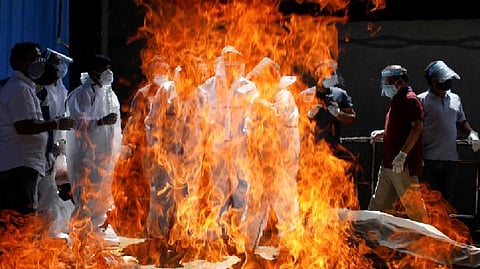

NEW DELHI: India is no stranger to political controversies. At least a half-dozen rage in its fractious public life at any time. But perhaps the most unseemly dispute recently has been the current one over the country’s COVID-mortality figures.The pandemic hit India hard, particularly during the second wave in April-June 2021, when people were dying from COVID-19 in hospital waiting rooms and parking lots, while others succumbed due to a lack of medical oxygen. Countless funeral pyres glowed in the darkness along the banks of the Ganges, even as some poor families, unable to afford a funeral, wrapped their loved ones in shrouds and sent them floating down the river.But, despite widespread anecdotal evidence of a catastrophic pandemic death toll,official Indian figures told a different, although still alarming, story. Prime Minister Narendra Modi’s government estimated that, between the start of the pandemic in January 2020 and March 2022, just over a half-million deaths were attributable to COVID-19. Many Indian journalists were skeptical, pointing out that the official figure was well below even the number of compensation payouts made by state governments to the families of COVID-19 victims.The respected British medical journal The Lancet published a study suggesting that India’s numbers were a gross under count. But the government stood its ground.It took an explosive report from the World Health Organization earlier this month to blow the lid off the government’s claims. Using the measure of “excess deaths” – based on pre-pandemic mortality rates in the same area – the WHO estimated the number of COVID-19 deaths in India at 4.7 million. That was nearly ten times higher than the government was prepared to admit, and accounted for almost a third of the estimated 15 million pandemic deaths globally.The government, which had at first tried unsuccessfully to stall the adoption of the report, denounced it, citing concerns about the WHO’s methodology. But, given tha tlower COVID-19 mortality figures are an essential part of the government’s messaging,the denials were widely seen as an attempt to counter unfavourable publicity about its management of the pandemic.India is an important member of the WHO, and its health minister chaired the body’s Executive Committee during the first year of the pandemic. It is safe to assume that, as a United Nations organization, the WHO has no desire to score political points against the government of a leading member state. But the need to have an accurate COVID-19 mortality count so that the world can prepare better for the next pandemic obliged the organization to ignore the sensitivities of national governments and issue its report. (Several other calculations and surveys had reached similar conclusions about the scale of COVID-19 mortality in India, with estimates putting the death toll at 3-5 million.)
Ironically, the WHO’s figures nonetheless confirm that India did not do all that badly relative to other countries in tackling the pandemic. Although India’s COVID-19 fatality rate of 1.2% of confirmed cases is the seventh highest globally, the country does not figure in the top 100 in terms of deaths per million population. Moreover, it is possible that many more people in India were infected than diagnosed, and that the true fatality rate is therefore lower, even if the absolute numbers are high as a result of India’s large population.
It would therefore have been better for the government to accept the WHO’s figures and frame them as relatively good news,rather than kicking up a controversy that
has put it in an unflattering light internationally. By challenging a well-established methodology used by epidemiologists worldwide, the government has triggered
much more discussion of the inadequacies of India’s civil registration system, its reporting of infections and deaths, and the credibility of its official statistics more generally.
India should have admitted that the draconian, Chinese-style lockdown the government imposed when the pandemic began in 2020 paralyzed much administrative activity, including the reporting and registration of deaths (not just from COVID-19). Field surveys were not conducted, and statistical sampling was based on inadequate data.
Tharoor, a former UN under-secretary-generaland former Minister of State for ExternalAffairs, and for HRD, is a Congress MP
Project Syndicate
Visit news.dtnext.in to explore our interactive epaper!
Download the DT Next app for more exciting features!
Click here for iOS
Click here for Android